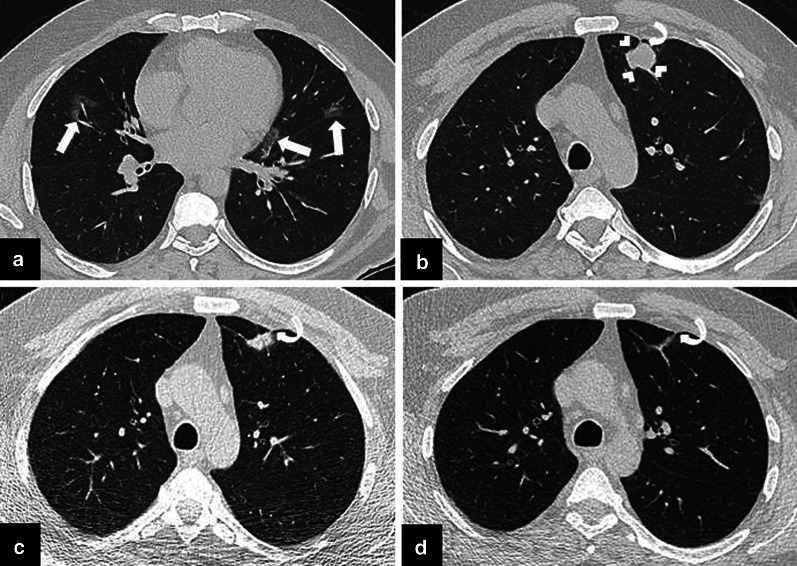Dear editor,
We read with great interest the educational review article titled ‘COVID-19 pneumonia: the great radiological mimicker’ by Duzgun et al. [1] in the November 2020 issue of Insights into Imaging. We agree with the authors that COVID-19 infection may mimic other airspace disorders on imaging. It is well known that the most common computed tomography (CT) finding of COVID-19 pneumonia is bilateral ground-glass opacity (GGO) with accompanying consolidation. However, the differentiation of COVID-19 infection with other disorders may not be straightforward due to various imaging findings. The incidence rate of irregular shaped solid nodules on CT scans of patients with COVID-19 infection has been reported as 3–12% in the literature [2–4]. We would like to share a challenging case of COVID-19 pneumonia presented with unusual imaging findings.
A 57-year-old smoker male patient presented to the emergency department with a 4-day history of cough and joint pain. His past medical history was unremarkable except for chronic kidney disease. Physical examination revealed abnormal lung sounds. The subsequent blood tests demonstrated lymphopenia (700/µl) and elevated level of C-reactive protein (10 mg/l). Chest CT was performed following polymerase chain reaction (PCR) test positivity for COVID-19 infection. An irregularly shaped solid nodule 2 cm in diameter was found in left upper lobe of the lung along with the CT findings compatible with COVID-19 pneumonia (Fig. 1a, b). Primary lung cancer could not be excluded with the imaging findings per se, in a smoker patient. According to the Fleischner Society 2017 guidelines [5], percutaneous transthoracic core needle biopsy was planned after the quarantine period ended. On pre-procedure CT scan, the nodule appeared to be decreasing in size with associated subpleural lines (Fig. 1c). Percutaneous biopsy procedure was avoided, and a follow-up CT was recommended. The follow-up CT scan obtained after 3 months revealed complete resolution of the nodule (Fig. 1d).
Fig. 1.
a, b The initial chest CT scan obtained following PCR test positivity for COVID-19 infection, revealed a few patchy areas of ground glass opacity (GGO) in both lungs (arrows) compatible with COVID-19 pneumonia. An irregularly shaped solid nodule 2 cm in diameter in left upper lobe of the lung was also noted (arrowheads). Percutaneous transthoracic core needle biopsy was scheduled due to suspicion of primary lung cancer. c CT scan obtained prior to biopsy procedure demonstrated significant size reduction of the nodule. Therefore, biopsy was not performed. d Follow-up CT scan obtained 3 months later demonstrated complete resolution of the nodule. A pleural tag which became more apparent following resolution of the nodule (curved arrows, b–d) raised the suspicion of COVID-19 triggered focal organizing pneumonia
In conclusion, CT is an indispensable tool in patients with clinical suspicion of COVID-19 infection. Imaging plays a significant role in the diagnosis and also evaluation of treatment response in COVID-19 infection. However, COVID-19 infection may result in various imaging findings since it is the great radiological mimicker as reported by Duzgun et al. [1]. Despite being rare, solitary pulmonary nodules with irregular margins are one of the many faces of COVID-19 infection. In the presented case, a pleural tag which gives rise to suspicion of organizing pneumonia was also observed on CT [6]. Spontaneously regressing solitary pulmonary nodule may be associated with organizing pneumonia which has been shown to occur secondary to COVID-19 infection [7].
Abbreviations
- COVID-19
Coronavirus disease 2019
- CT
Computed tomography
- GGO
Ground-glass opacity
- PCR
Polymerase chain reaction
Authors' contributions
All authors contributed equally in writing and editing the manuscript. All authors read and approved the manuscript.
Funding
None.
Availability of data and materials
Data sharing is not applicable to this article as no datasets were generated or analyzed during the current study.
Declarations
Ethics approval
Not applicable.
Consent for publication/consent to participate
Informed consent was obtained from the patient.
Competing interests
The authors declare that they have no competing interests.
Footnotes
Publisher's Note
Springer Nature remains neutral with regard to jurisdictional claims in published maps and institutional affiliations.
References
- 1.Duzgun SA, Durhan G, Demirkazik FB, Akpinar MG, Ariyurek OM. COVID-19 pneumonia: the great radiological mimicker. Insights Imaging. 2020;11(1):1–15. doi: 10.1186/s13244-020-00933-z. [DOI] [PMC free article] [PubMed] [Google Scholar]
- 2.Ai T, Yang Z, Hou H, et al. Correlation of chest CT and RT-PCR testing for coronavirus disease 2019 (COVID-19) in China: a report of 1014 cases. Radiology. 2020;296(2):E32–E40. doi: 10.1148/radiol.2020200642. [DOI] [PMC free article] [PubMed] [Google Scholar]
- 3.Ye Z, Zhang Y, Wang Y, Huang Z, Song B. Chest CT manifestations of new coronavirus disease 2019 (COVID-19): a pictorial review. Eur Radiol. 2020;30(8):4381–4389. doi: 10.1007/s00330-020-06801-0. [DOI] [PMC free article] [PubMed] [Google Scholar]
- 4.Pan Y, Guan H, Zhou S, et al. Initial CT findings and temporal changes in patients with the novel coronavirus pneumonia (2019-nCoV): a study of 63 patients in Wuhan, China. Eur Radiol. 2020;30(6):3306–3309. doi: 10.1007/s00330-020-06731-x. [DOI] [PMC free article] [PubMed] [Google Scholar]
- 5.MacMahon H, Naidich DP, Goo JM, et al. Guidelines for management of incidental pulmonary nodules detected on CT images: from the Fleischner society 2017. Radiology. 2017;284(1):228–243. doi: 10.1148/radiol.2017161659. [DOI] [PubMed] [Google Scholar]
- 6.Akira M, Yamamoto S, Sakatani M. Bronchiolitis obliterans organizing pneumonia manifesting as multiple large nodules or masses. AJR Am J Roentgenol. 1998;170(2):291–295. doi: 10.2214/ajr.170.2.9456931. [DOI] [PubMed] [Google Scholar]
- 7.Pogatchnik BP, Swenson KE, Sharifi H, Bedi H, Berry GJ, Guo HH. Radiology-pathology correlation in recovered COVID-19, demonstrating organizing pneumonia. Am J Respir Crit Care Med. 2020;202(4):598–599. doi: 10.1164/rccm.202004-1278IM. [DOI] [PMC free article] [PubMed] [Google Scholar]
Associated Data
This section collects any data citations, data availability statements, or supplementary materials included in this article.
Data Availability Statement
Data sharing is not applicable to this article as no datasets were generated or analyzed during the current study.



